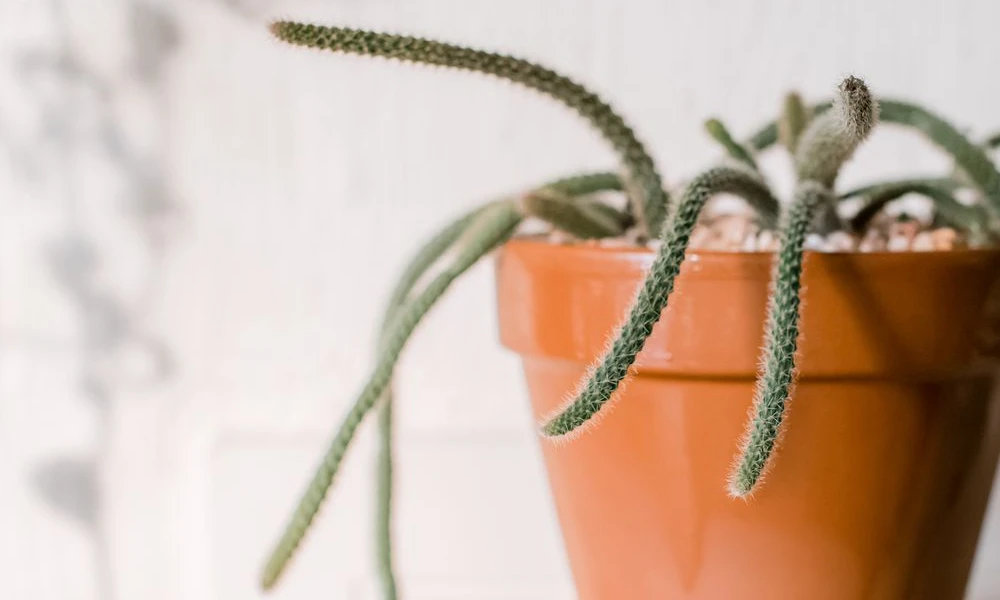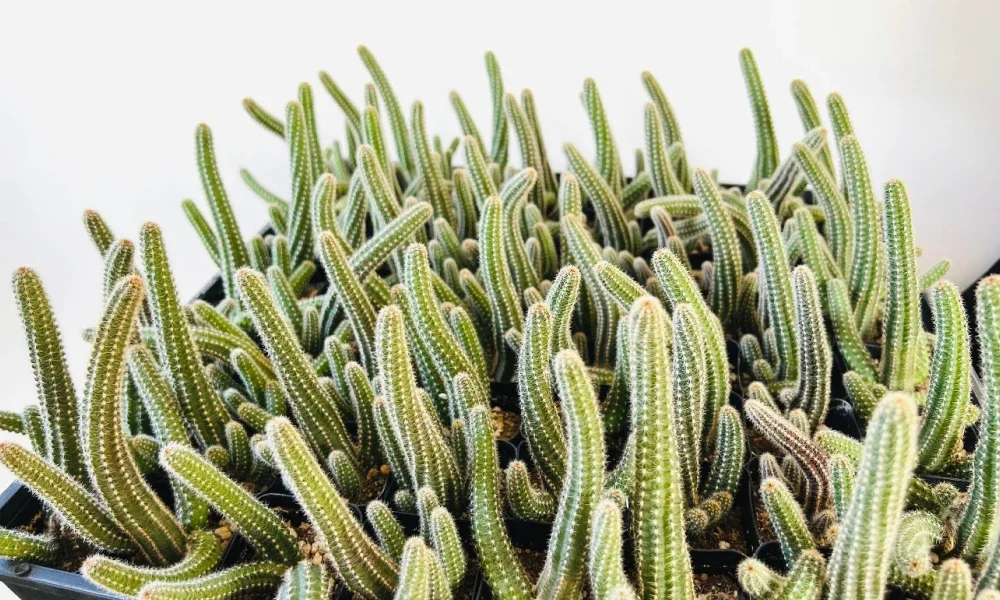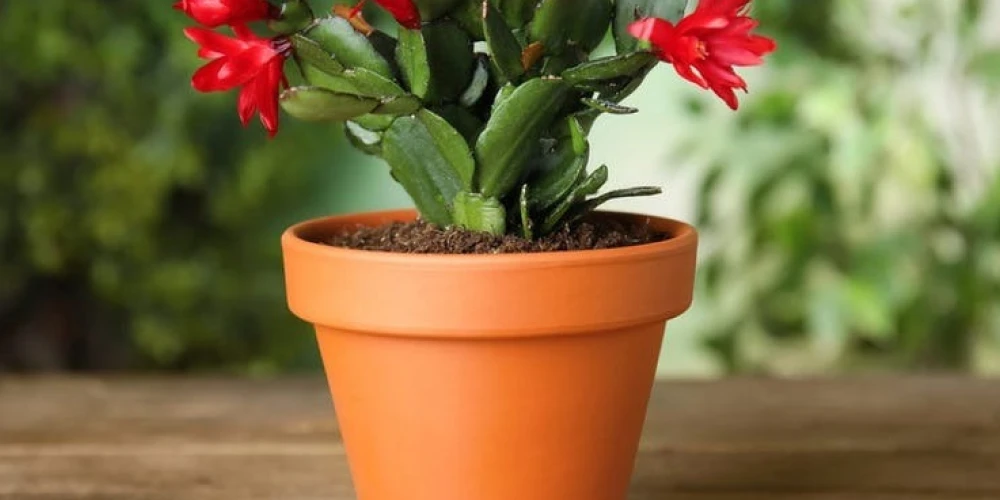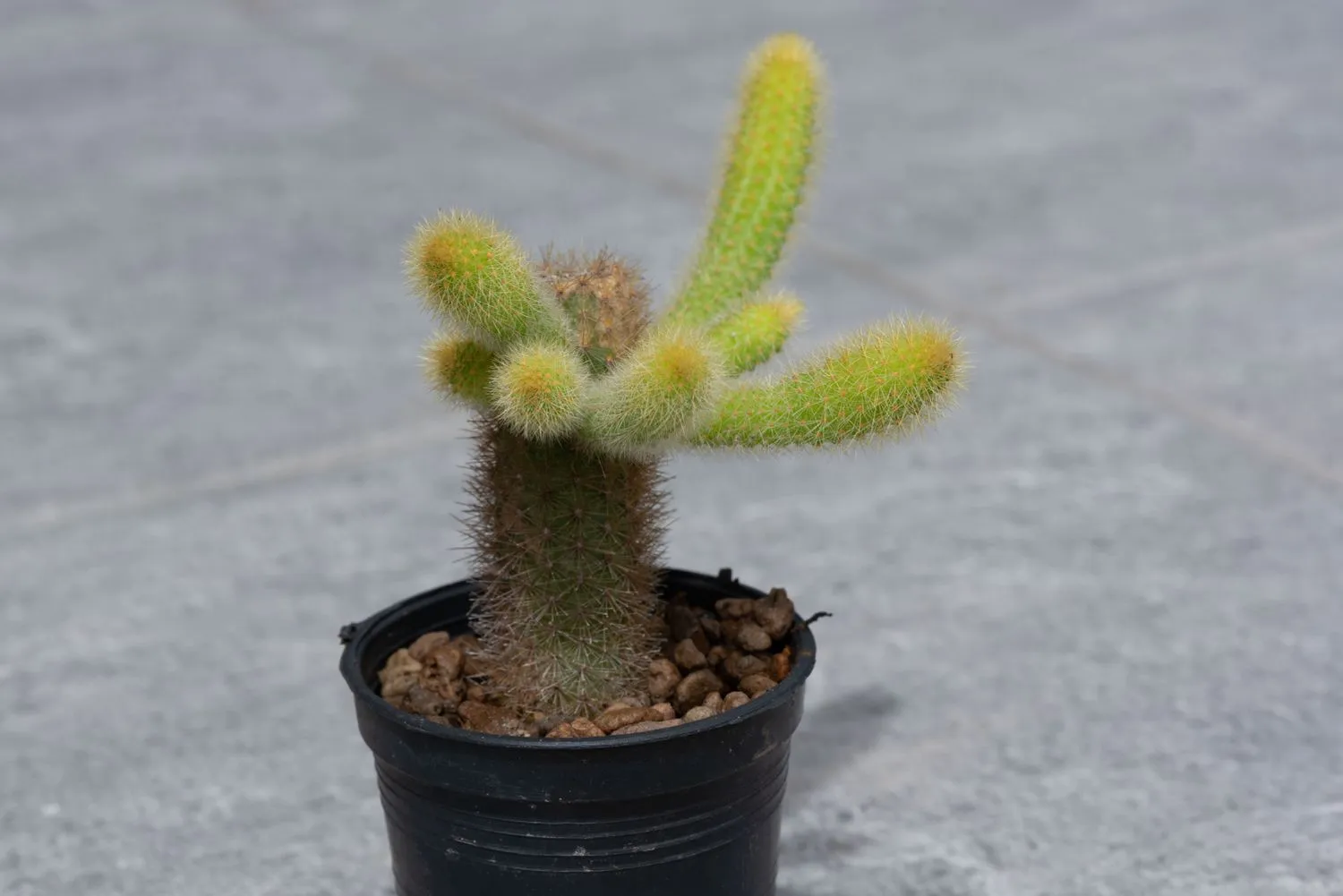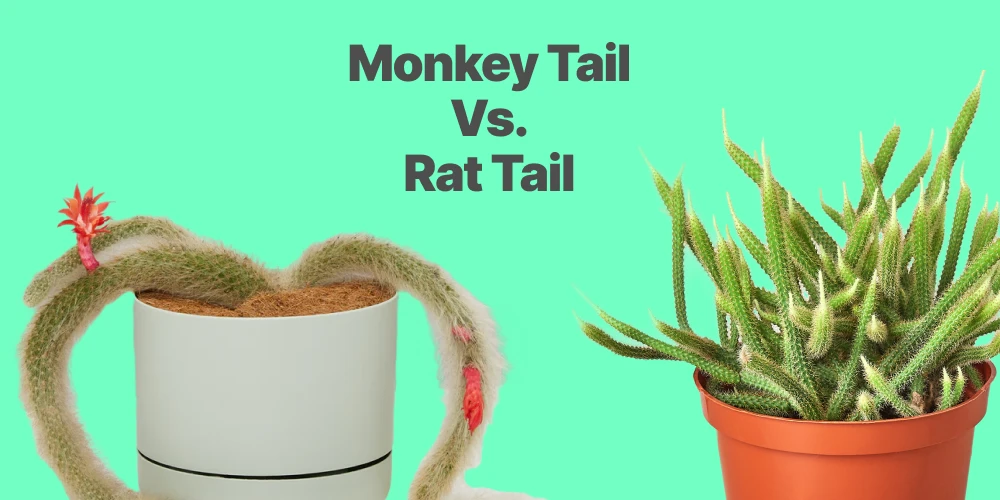These cacti are beloved by enthusiasts for their distinctive appearances and low-maintenance care requirements. Despite their similarities, they each possess unique characteristics that suit different environments. In this comparison, we’ll explore the key differences and similarities between the Rat Tail Cactus and the Peanut Cactus care, helping you decide which is best for your collection or garden.
Overview of Rat Tail Cactus
The Rat Tail Cactus, scientifically known as “Aporocactus flagelliformis,” is notable for its long, slender stems, which can grow up to several feet long and resemble a rat’s tail (1).
The cactus produces vibrant pink to red flowers, which are large and tubular and bloom in spring, adding a striking visual appeal.
Its trailing growth habit makes it ideal for hanging baskets or containers where it can cascade over the sides.
Here are the key features of Rat Tail Cactus:
| Scientific Name | Aporocactus flagelliformis |
| Common Names | Rat Tail Cactus, Creeping Devil, Rattail Cactus |
| Size | Stems can grow up to 4 feet (1.2 meters) long |
| Blooming Season | Spring to early summer |
| Light Requirements | Bright indirect light tolerates some direct sunlight |
| Watering Needs | Allow soil to dry out completely between waterings; reduce in winter |
| Soil | Well-draining cactus or succulent mix |
| Temperature Tolerance | Prefers warm temperatures, protect from frost |
| Humidity Preference | Low humidity levels, typical of desert environments |
By understanding these features, you can decide if a Rat Tail Cactus is the perfect addition to your collection!
How to grow and care for Rat Tail Cactus?
Here’s a breakdown of how to grow and care for this relatively low-maintenance cactus:
- Light: Provide ample sunshine, mimicking their desert habitat. A south-facing window is ideal, though east or west with some direct sun works too.
- Soil: Drainage is crucial. Use a lightweight, well-draining cactus or succulent mix. Alternatively, create your own by combining potting soil, perlite, and sand.
- Water: Water moderately during spring and summer, letting the soil dry out completely between waterings. During winter, watering is reduced significantly as the cactus enters dormancy. Aim to prevent shriveling but avoid overwatering.
- Temperature and Humidity: Regular room temperatures (60-75 degrees Fahrenheit) are perfect. Nighttime temperatures ideally should be around 60-70 degrees Fahrenheit. Protect the cactus from freezing temperatures and drafts. Average home humidity levels are suitable; avoid excessively high humidity that can cause rot.
- Fertilizer: During spring and summer (growing season), you can use a diluted liquid fertilizer formulated for cacti roughly once every two weeks.
- Potting and Repotting: Choose a pot with drainage holes. Repotting every 1-2 years in a slightly larger pot with fresh potting mix is recommended as the cactus tends to be root-bound.
Overview of Peanut Cactus
The Peanut Cactus, also known as “Echinopsis chamaecereus”, is a famous cactus prized for its beautiful flowers and trailing stems (2).
These cacti start small and round, resembling peanuts, but mature into clusters of finger-like stems reaching up to a foot long.
| Common Names | Peanut Cactus |
| Size | Stems can grow up to 6 inches (15 cm) tall |
| Flowers | Bright orange to red, funnel-shaped flowers |
| Blooming Season | Spring to summer |
| Light Requirements | Enjoys bright, indirect light to full sun; can tolerate direct sunlight with acclimatization |
| Watering Needs | Water thoroughly when the top inch of soil is dry during the growing season; reduce watering in winter |
| Soil | Requires well-draining cactus or succulent mix |
| Temperature Tolerance | Prefers temperatures between 65-80°F (18-27°C); protect from temperatures below 50°F (10°C) |
| Humidity Preference | Prefers dry conditions; tolerates typical household humidity levels |
How to grow and care for Peanut Cactus?
Here’s how to cultivate and care for your Peanut Cactus:
- Light: Mimic their desert origins – give them plenty of bright, indirect sunlight. Direct sun is okay, but afternoon shade is helpful, especially in hot climates.
- Soil: Drainage is vital! Use a well-draining cactus mix, or create your own with potting soil, perlite, and sand.
- Water: Water deeply but infrequently, allowing the soil to dry out completely between waterings. Err on the side of underwatering – they’d rather be dry than soggy. Reduce watering significantly in winter.
- Temperature: They like warmth, ideally between 50 and 80 degrees Fahrenheit. They can tolerate some cold, but they should be protected from frost.
- Fertilizer: It’s not essential, but a diluted cactus fertilizer applied a few times during the growing season can be a nice boost.
- Potting and Repotting: Choose a pot with drainage holes. As they grow, they should be repotted every few years into a slightly larger pot with fresh, well-draining mix.
What is the difference between Rat Tail Cactus and Peanut Cactus?
Choosing between a Rat Tail Cactus and a Peanut Cactus depends on your desired look.
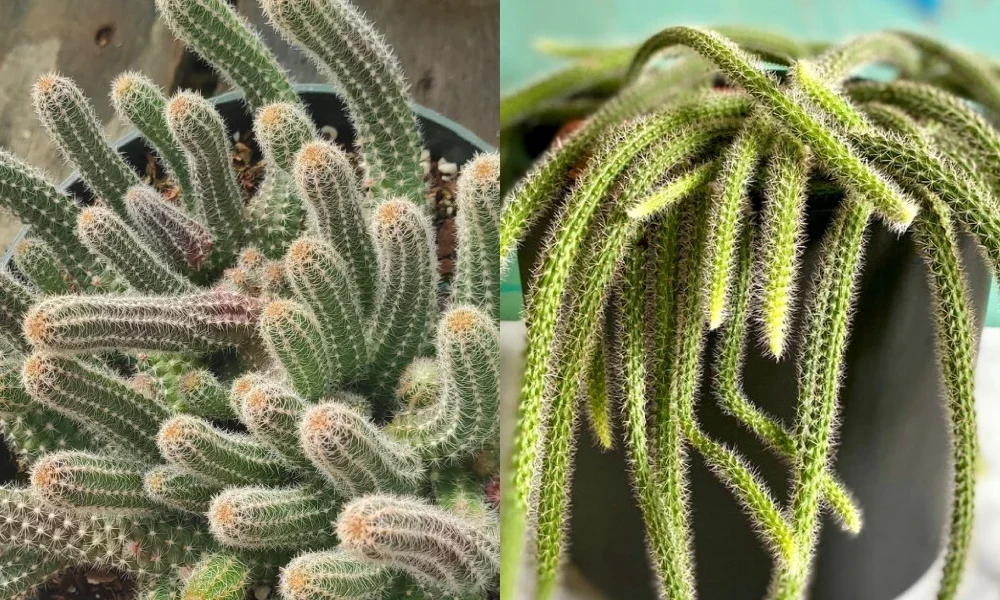
Rat Tail Cactus boasts long, cascading stems that drape elegantly, while Peanut Cactus forms a charming cluster of finger-like stems that grow upright with a gentle curve.
Both cacti produce beautiful blooms, Rat Tail with red or pink flowers, and Peanut with vibrant orange-red blooms.
Light needs are similar, with both preferring bright conditions. However, Rat Tail thrives in full sun, while Peanut prefers some indirect sun with some direct sun, which is okay.
Watering is similar, with both needing complete drying between waterings, but Rat Tail might need slightly more frequent watering during active growth.
Here is a comparison between the Rat Tail Cactus and the Peanut Cactus:
| Feature | Rat Tail Cactus | Peanut Cactus |
| Family | Cactaceae | Cactaceae |
| Origin | Mexico and Central America | South America, specifically Argentina |
| Growth Habit | Trailing, cylindrical stems covered in fine spines | Clumping cactus with cylindrical, segmented stems |
| Size | Stems can grow up to 4 feet (1.2 meters) long | Stems can grow up to 6 inches (15 cm) tall |
| Flowers | Bright pink to red, tubular flowers | Bright orange to red, funnel-shaped flowers |
| Blooming Season | Spring to early summer | Spring to summer |
| Light Requirements | Thrives in bright indirect light; tolerates some direct sunlight | Enjoys bright, indirect light to full sun; can tolerate direct sunlight with acclimatization |
| Watering Needs | Allow soil to dry out completely between waterings; reduce in winter | Water thoroughly when the top inch of soil is dry during the growing season; reduce watering in winter |
| Soil | Requires well-draining cactus or succulent mix | Requires well-draining cactus or succulent mix |
| Temperature Tolerance | Prefers warm temperatures; protect from frost | Prefers temperatures between 65-80°F (18-27°C); protect from temperatures below 50°F (10°C) |
| Humidity Preference | Low humidity levels, typical of desert environments | Prefers dry conditions; tolerates typical household humidity levels |
| Maintenance | Minimal pruning; watch for pests and overwatering | Low maintenance; watch for pests and overwatering; occasional pruning may be needed |
Rat tail cactus vs Peanut cactus: care difference
Both Rat Tail Cactus and Peanut Cactus are popular choices among cactus enthusiasts, but they have some care differences:
- Light Requirements: Both cacti prefer bright, indirect light. They can tolerate some direct sunlight, especially the morning sun, but avoid intense afternoon sun to prevent sunburn.
- Watering: Rat Tail Cactus needs thorough watering when the top inch of soil dries in spring and summer, reducing water in winter. Peanut Cactus prefers moderate watering, allowing the top half-inch of soil to dry in spring and summer, with minimal winter watering to prevent soil dryness.
- Soil and Potting: Both cacti prefer well-draining soil mixtures designed for cacti or succulents. A mix of potting soil, sand, and perlite is suitable.
- Temperature and Humidity: They prefer temperatures between 65-80°F (18-27°C) during the growing season and slightly cooler temperatures in winter. They can tolerate low humidity but appreciate slightly higher humidity levels during their active growth periods.
- Fertilizing: Feed with a balanced, diluted cactus fertilizer about once a month during the growing season (spring and summer). Avoid fertilizing during the winter months.
- Propagation: Both cacti can be propagated from stem cuttings. Allow cuttings to callous for a few days before planting them in a well-draining soil mix.
Common Issues and Solutions for Rat Tail Cactus and Peanut Cactus
Some of the common issues and solutions for Rat Tail Cactus and Peanut Cactus include:
Overwatering
Overwatering is a common issue for both Rat Tail Cactus and Peanut Cactus, leading to yellowing or mushy stems and root rot.
To prevent this, ensure the soil is well-draining and allow it to dry out completely between waterings.
Use a well-draining soil mix and ensure the pot has drainage holes. Water sparingly, especially during the dormant winter months for the Rat Tail Cactus.
Underwatering
Both cacti can suffer from underwatering, resulting in shriveled and wrinkled stems. To address this, water thoroughly when the soil is completely dry, increasing the watering frequency during the growing season, which is in spring and summer.
Insufficient Light
Insufficient light causes weak, elongated stems and loss of color in the Rat Tail Cactus and stretched, pale stems and reduced flowering in the Peanut Cactus.
Place the cacti in bright locations with indirect sunlight, preferably in a south or west-facing window. Supplement with grow lights if natural light is insufficient.
Pests
Pests such as mealybugs and spider mites can infest both Rat Tail and Peanut Cacti, leading to general poor health and deformed growth. Isolate affected plants and treat them with insecticidal soap, neem oil, or rubbing alcohol.
For severe infestations, consider using systemic insecticides or consulting a professional.
Temperature Extremes
Both cacti are sensitive to temperature extremes, which can cause blackened tips from frost damage or scorched patches from heat damage.
Maintain a temperature range between 50-80°F (10-27°C) to protect them from frost in winter and avoid direct midday sun in summer.
Poor Soil Quality
Poor soil quality may result in slow growth, poor drainage, and nutrient deficiencies in both Rat Tail and Peanut Cacti.
For better drainage and soil quality, use a cactus-specific potting mix or regular potting soil with added sand or perlite.
Inadequate Fertilization
Poor growth, yellowing, and lack of flowers in Peanut Cactus can result from inadequate fertilization. During the growing season, fertilize with a diluted, balanced cactus fertilizer to promote healthy growth while avoiding over-fertilization.
Root Bound
Stunted growth and roots from drainage holes indicate that Peanut Cactus may be root-bound. Repot the cactus every 2-3 years into a slightly larger pot with fresh cactus mix to ensure it has enough space to grow.
By addressing these common issues and following the suggested solutions, you can ensure that both Rat Tail and Peanut Cacti thrive in their environments.
Conclusion
The Rat Tail Cactus and the Peanut Cactus each offer their unique charm and appeal. Both cacti are relatively easy to care for, making them great choices for novice and experienced gardeners.
Whether you choose the elegant Rat Tail Cactus or the compact and quirky Peanut Cactus, you’ll add a fascinating and beautiful plant to your collection.

